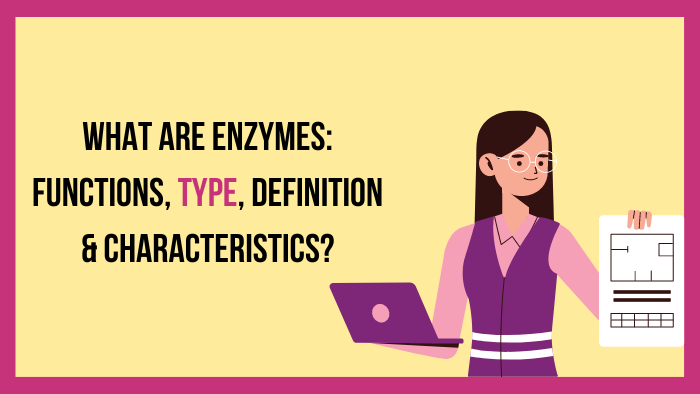
January 06, 2022
What Are Enzymes: Functions, Type, Definition & Characteristics
No 1 Assignment Help
is only a click away.
What Are Enzymes: Functions, Type, Definition & Characteristics? | A Student Guide
Biology students may be confused about what enzymes imply in biology. That is why we have compiled a list of What Are Enzymes: Functions, Type, Definition & Characteristics for you. And we've gathered all of the necessary and sumptuous information for you right here.
.png)
Enzymes and microorganisms from the environment are active everywhere, from converting sugar into energy in your cells to aiding photosynthesis in the trees and plants beyond your sight. They may be little, yet they have a big effect. Enzymes, which are a kind of protein, are found in all living things. They are natural chemicals emitted by the source that enhance chemical processes without requiring any active participation. They begin to operate as long as the "material" is there.
It is analysed that potential structures (typical proteins) were discovered to dramatically accelerate practically all electrochemical processes within cells. They are vital for overall and conduct a variety of important functions in the body, including as helping food and oxygen.
What Are Enzymes and How Do They Work | A complete guide on characteristics of enzymes-
“Biological polymers that catalyse biochemical events are known as enzymes.”
The preponderance of enzymes is proteins with catalytic characteristics of enzymes required to carry out various operations. A group of enzymes required for life carry out physiological functions and other organic compounds in the cell.
The initial stage of physiological activities is carried out by enzymes that react with a conducting polymer. Enzymes are produced as a result of the transformation of the inputs into other molecules.
Enzyme inhibition has long been used in diagnostic kits because of its relevance in promoting the photosynthetic process. With exception of ribozymes, which are RNA catalysts, all proteins have peptide as their nucleic acid constituent. The name ribozyme comes from the ribonucleic acid enzyme. Ribonucleic acid organisms called ribozymes accelerate reactions in their links and between RNAs. If you are still unsure about- “What Are Enzymes: Functions, Type, Definition & Characteristics”, then contact us via email or phone! We are one click away from you!
Enzyme Characteristics
Practically all enzymes are proteins, while some catalytic active RNA molecules have been discovered as well.
Colloidal nature: Enzymes reside as hydrophilic colloids in the protoplasm. They are recovered by haemodialysis because of their colloidal structure.
Specificity of the substrate: Only one response or a similar reaction is catalysed by a specific enzyme. Maltase, for example, works only on maltose, but pancreatic lipase works on a range of lipids. Various enzymes may react to the same substrates in diverse ways, resulting in different end products. The plasmid in the regulatory region and the optically monomeric shape of the s determine the enzyme’s target selectivity.
Catalytic qualities: - For each physiological response, genes encode a minimal concentration.
- They don’t start the catalysis, but they do speed it up by decreasing the electrostatic attraction.
- At the end of the response, they are unaltered.
- Their existence does not affect the ultimate product’s qualities.
- They speed up or slow down forward or backward responses to achieve equilibrium, but they don’t change the balance.
- Reversible enzyme-catalysed reactions are common, but not always.
- They need to be hydrated to be active.
In Organic Chemistry, There Are Six Different Types Of Enzymes.
These strategies are implemented based on how the characteristics of enzymes at a molecular level. They’re crucial to determining organic chemistry (learn more with this course).
Oxidoreductases, reductases, dehydrogenases, lyases, isomerases, and laccases are the six categories of enzymes. The most prevalent type is hydrolase, followed by oxidoreductases and reductases. They make up more than half of all known enzymes.
- Oxidoreductases - Oxidoreductases are enzymes that catalyse the levels to fall of molecules. The electrons are transferred from one molecule (the reductant) to the other in these interactions (the oxidant). These events are necessary for life because they are involved in critical cellular metabolism such as glycolysis, which operates in almost every species on the planet.
- Transferases - The transfer of a compound (methylation) from one molecule elsewhere is catalysed by membrane protein enzymes. The first component is known as the donor, while the second is known as the acceptor. These are among the most fundamental and essential behaviours in life.
.png)
- Hydrolases - Hydrolysis is the breakdown of covalent bonding with the mixing, which is what the dehydrogenases do. Over 200 hydrolases have been found, ranging from those that act as reducing agents to those that cleave ester connections and far more. Endohydrolase elements create proteins towards the end of the chain, while exohydrolase enzymes cut proteins in the centre.
- Lyases - Lyase enzymes catalyse lysis events, which result in the formation of a double bond. Non-hydrolytic or oxidative removal reactions are known as lysis reactions. The enzymes known as lyases are also known as generative s. It’s also conceivable to have a Michael addition, which is the opposing view.
The Purposes of Enzymes
In the human body, the characteristics of enzymes serve a variety of purposes. These are some of them:
- Enzymes aid transaction history. Protein kinase, which catalyses the phosphorylation of proteins, is the most prevalent enzyme used for the method.
- They crumble giant chemicals into low molecular weight compounds that the body normally absorb.
- They aid in the production of cells of the body. The enzymes responsible for energy creation are known as ATP synthase.
- Enzymes control the transport of ions across the cell surface.
- To clear semi contaminants, enzymes undertake various biochemical reactions such as oxidation, decrease, digestion, and others.
- They do their job.
Here you might get the solution of What Are Enzymes: Functions, Type, Definition & Characteristics under one roof. Moreover, you can also contact us for the enzymes assignments if you are stuck with your assignments. Online Assignment Expert is just a one-stop destination to learn more about the biology subject expertise.
- You can reach out to us via the student portal, which is where we prefer to get all of the facts about the homework that are presented in various lectures, Facebook groups, and other places.
- We provide special discounts to our pupils on every project; you may learn more about our offerings by visiting our website.
- We have a dedicated staff of experts and writers who follow a six-sigma quality management system and provide happy hour services.
- If you are having trouble with your projects because to XYZ reasons or professional dishonesty, our specialists are available to help you 24 hours a day, 7 days a week.
You will get to learn more biology topics with us. Connect with us through a call, email or message to get more sumptuous information!
Related Blogs
Subscribe Our Newsletter & get Information about latest courses









